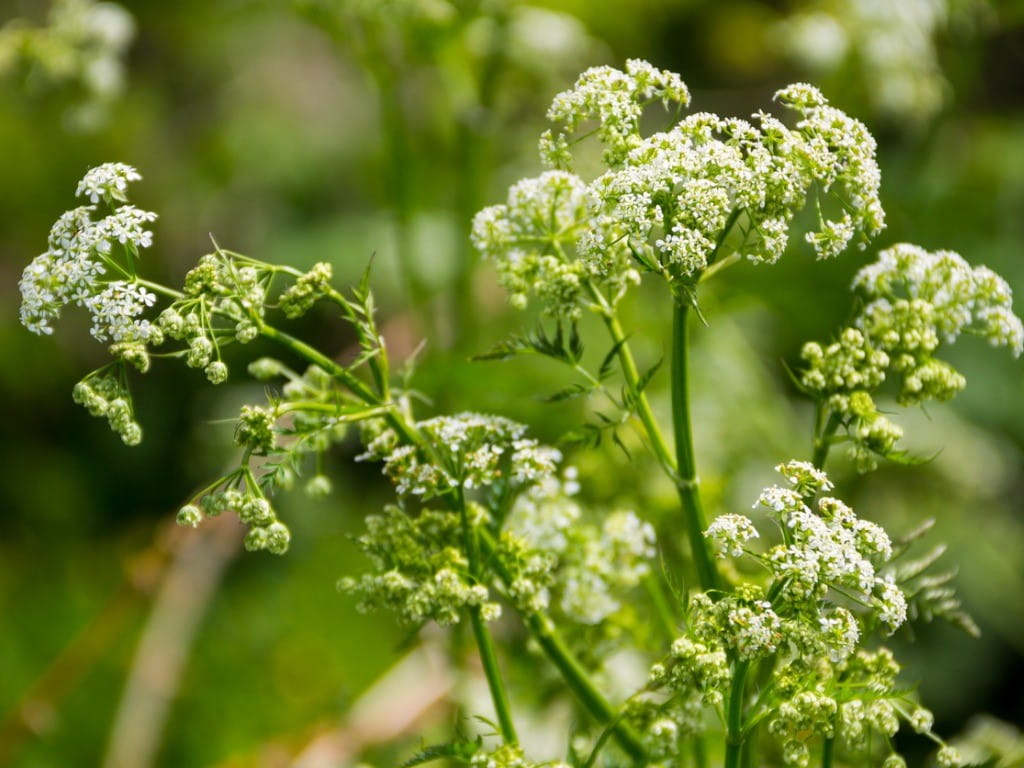Can Poison Hemlock Be Deadly?

The Bottom Line
Poison hemlock is a deadly plant that looks dangerously similar to other edible plants. Modern day exposures are often the result of plant misidentification.

Poison hemlock is one of the more romantic and exciting topics in plant toxicology. The plant is not native to North America, but in the 1800s it was introduced from across the Atlantic for its ornamental value. Today, poison hemlock is found across most of North America.
Historically, poison hemlock was used as medicine (to treat muscle spasms and cause sedation as well as being applied to tumors), but it is most famously known as the method of death chosen by Socrates in 399 BCE. People usually do not eat it intentionally, but rather it is often misidentified as something edible.
The scientific name for poison hemlock is Conium maculatum. The stems are smooth, hollow, and bright green in color, and have red or purple spots; macula is the Latin word for "spot". The leaves are segmented like a fern and described as "lacy". Poison hemlock often has a bad smell described as like "mouse urine" or "musty". The naturally occurring poisons, most notably coniine, are in all parts of the plant.
Poison hemlock belongs to the same plant family (Apiaceae) as carrots, parsnips, fennel, and dill. The plants often involved with foraging mistakes are also a part of the Apiaceae family: angelica, cow parsnip, wild parsnip, wild chervil, wild celery, and Queen Anne's lace. It is difficult to properly identify these plants. To complicate matters, at some phases of the life cycle, common characteristics of poison hemlock, such as spotting or bad smell, might not be present. Concentrations of the poisonous components will vary among plants and are affected by growing conditions. Foraging for edible plants can be fun and rewarding but it can also be dangerous. If you are interested in foraging, join an experienced local group or obtain a field guide with clear pictures and descriptions.
Poison hemlock is a persistent plant that can produce more than 35,000 seeds that can be easily spread by water and animals. The seeds are stable for 3-6 years waiting for the right conditions to sprout and start growing. There are countless cases of animal deaths due to hemlock poisonings because of the plant's rapid growth and intermixing into pastures. The impact on the livestock industry is substantial, and farmers know that poison hemlock must be removed immediately.
If you find poison hemlock in your yard, remove it quickly to keep it from spreading. Wear gloves and pull up the entire plant, including the roots. Your local Office of Agriculture might be willing to help you remove poison hemlock.
The toxicity of coniine has been well documented in livestock, and exposure to the plant is more dangerous for cows than other animals. Initially, there is an excitatory phase with nervousness, tremors, and difficulty walking. Major toxicity and death occur when a depression phase develops. The heart and the diaphragm muscles can slow down more and more, causing death. In humans, coniine affects the nervous system and causes tremors, paralysis, and breathing difficulties. Muscle damage and kidney failure may occur in severe cases. A person with poison hemlock toxicity can usually be successfully treated in a hospital. However, severe symptoms can develop quickly, so it is not safe to try to treat a poison hemlock exposure at home.
Pela Soto, PharmD, BSHS, BS
Certified Specialist in Poison Information
Poisoned?
Call 1-800-222-1222 or
Prevention Tips
- If you are interested in foraging for wild plants, join an organization with experienced members.
- Never eat an unknown plant or berry without verification from a clear field guide or someone with experience.
- Poison hemlock is dangerous and can be deadly. Do not manage symptoms at home if they occur.
This Really Happened
A husband and wife, both 45 years old, ate "wild celery" picked from a regional park. They felt unwell soon afterward and were transported to an ER by paramedics. They both complained of nausea, dizziness, blurred vision, and limb weakness.
The man received a dose of activated charcoal and his symptoms resolved in 8 hours. The woman became very drowsy and stopped breathing approximately 2 hours after eating the plant. She had to be put on a ventilator to support her breathing. She was able to be taken off breathing support on day 2 of her hospital stay and was sent home on day 3 without any lasting effects.
The hospital took blood samples from both and did a very specific test to see if they could identify the toxin found in poison hemlock. Interestingly, only the husband was positive, even though the wife had more significant symptoms. The authors suggest that it was because her sample was taken later and the active toxin might be cleared from the body quickly.
(from Chen et al., 2017)
For More Information
References
Chen HY, Horng H, Rowley F, Smollin C. Rapid respiratory arrest after ingestion of poison hemlock mistaken for wild celery. Clin Toxicol (Phila) 2017;55:155-6.
Conium L. Interagency Taxonomic Information System [accessed 4 Dec 2018].
López TA, Cid MS, Bianchini ML. Biochemistry of hemlock (Conium maculatum L.) alkaloids and their acute and chronic toxicity in livestock. A review. Toxicon. 1999 Jun;37(6):841-65.
Lung DD, Scott BJ, Wu AH, Gerona RR. Prolonged ventilatory failure and flaccid quadriparesis after ingestion of poison hemlock. Muscle Nerve. 2013 Nov;48(5):823-7.
Vetter J. Poison hemlock (Conium maculatum L.). Food Chem Toxicol. 2004 Sep;42(9):1373-82.
Poisoned?
Call 1-800-222-1222 or
Prevention Tips
- If you are interested in foraging for wild plants, join an organization with experienced members.
- Never eat an unknown plant or berry without verification from a clear field guide or someone with experience.
- Poison hemlock is dangerous and can be deadly. Do not manage symptoms at home if they occur.
This Really Happened
A husband and wife, both 45 years old, ate "wild celery" picked from a regional park. They felt unwell soon afterward and were transported to an ER by paramedics. They both complained of nausea, dizziness, blurred vision, and limb weakness.
The man received a dose of activated charcoal and his symptoms resolved in 8 hours. The woman became very drowsy and stopped breathing approximately 2 hours after eating the plant. She had to be put on a ventilator to support her breathing. She was able to be taken off breathing support on day 2 of her hospital stay and was sent home on day 3 without any lasting effects.
The hospital took blood samples from both and did a very specific test to see if they could identify the toxin found in poison hemlock. Interestingly, only the husband was positive, even though the wife had more significant symptoms. The authors suggest that it was because her sample was taken later and the active toxin might be cleared from the body quickly.
(from Chen et al., 2017)
